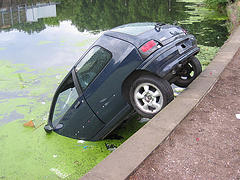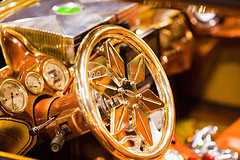4. Airplanes are safer than cars
As we now know, adjectives are used not only to describe things, people and places, but also to compare them. Remember that we make comparisons by adding suffix -er to short adjectives and using the adverb more in front of longer ones. We will study it in depth later in the unit. Now, just have a look at the following chart to be able to recognize the comparative sentences that appear in the text in Section 1.

|
|

|
| By Vicente Alfonso. C. Commons |
By Vicente Alfonso. C. Commons |
| Comparative | Conjunction |
|
older newer longer shorter |
than |
|
more interesting more expensive |
than |
Have a look at the photos above. We could say, for example: The photo on the left is older than the photo on the right or The picture on the right is more recent than the picture on the left.
Remember that comparison is a property not only of adjectives but also of adverbs. It describes the degree to which the modifier (adjective or adverb) modifies its complement (nouns in the case of adjectives and nouns, other adjectives and even other adverbs in the case of adverbs).
We will study two degrees of adjectives and adverbs:
| Comparative | Superlative |
| safer / more interesting |
safest / most interesting |
| more friendly | most friendly |
 |
| By Elsie esq. C. Commons |

|
| By VOD Cars. C. Commons |
Remember that there are several degrees of comparison. So, apart form comparisons of superiority, we can also find comparisons of equality and inferiority. In them, we use the positive adjective or adverb to make or draw the comparison (e.g. Coaches are as fast as cars, Paco speaks English less fluently than Sonia).
Find out all the comparisons you can find in the text in Section one. Pay attention to all kinds of comparisons.
Read the paragraph below and fill in the missing words. Choose from the words in the box.
| richer - bigger - more expensive - faster - greater - safer |
 |
| By Jake Bouma. C. Commons |
 |
| By Estherase. C. Commons |
There are lots of means or modes of transport. The car is probably the one that most people use. However it is not the safest way of travelling. In fact, road traffic accidents are one of the most common sources of personal injury. And everybody knows that the the car's engine, the the chance of car accidents. That being so, excessive speed is one of the most common contributory factors in fatal accidents. Undoutedly, the plane is and , but it is also than any other mode of transport. When people travel long distances, they frequently take airplanes, and this is what Paco has done to travel from the United States to South Africa. He isn't worried about how expensive flying is. He has won the lottery! So, he is now than he had ever expected!
Driving on the wrong side?
 |
| By Thomas Hawk. C. Commons |
Under King George III, the Government also issued a Highway Act (1773) which recommended people to keep to the left on public roadways and streets.
Countries that became part of the British Empire adopted this keep-left rule.